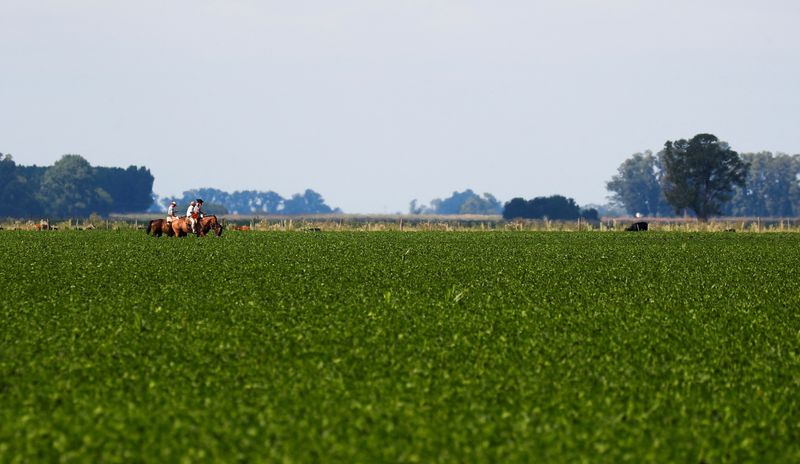2/2

© Reuters. People on horses ride past a soy plantation affected by a long drought that finally ended this month by the arrival of rain, is pictured in a farm in 25 de Mayo, in the outskirts of Buenos Aires, Argentina January 24, 2022. REUTERS/Agustin Marcarian
2/2
By Maximilian Heath
BUENOS AIRES (Reuters) – Heavy rains in Argentina’s farm belt and expectations of more to come are alleviating fears about a prolonged drought hitting crops after a dry start of the year, with some forecasters even concerned that too much water could affect soy and corn harvests.
The recent rain, which comes on the back of months of dry weather that have hammered crop production estimates, marks an important shift for the South American country, the world’s No. 1 exporter of processed soy and No. 2 for corn.
“The rains in recent days were very good in a large part of the agricultural area,” said Esteban Copati, head analyst at the Buenos Aires grains exchange, which cut its soy and corn outlook sharply in February due to the drought.
“What these rains allow is to sustain our current outlook. It stops the deterioration.”
Copati added, however, that there would not be any rebound in harvest forecasts, currently set at 51 million tonnes for corn and 42 million tonnes for soy because the crops had already been hit hard by the drought and were now well advanced.
Germán Heinzenknecht, a local meteorologist at the Applied Climatology Consultancy, told Reuters that forecasts of “important” rainfall over the coming weekend would add to recent precipitation, capping crop losses.
“The ones coming between Friday and Sunday are very important rains, especially in the center of Santa Fe, Entre Ríos, the east of Córdoba, they can be widespread rains of 80-90 millimeters (3.15-3.54 inches),” he said.
Heinzenknecht added that rainfall in the central farm belt should now easily reach the March average of 120-130 mm, and could become a worry in itself if it hampered the harvest that has started early for corn and will start in late March for soy.
“The only thing (farmers) don’t want now is to have excess water not allowing them to harvest,” he said.
“These rainfalls are good, it’s a good sign, but hopefully the second fortnight of March will come with a little more sun. That’s key for the harvest.”
Source: Investing.com





























